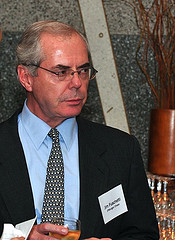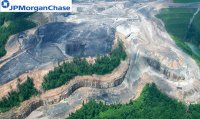Martin Mudd is an anti-strip mining activist who manages a Facebook group asking that JP Morgan Chase stop financing mountaintop removal. Members of Martin’s group closed their accounts with Chase today in protest of the company’s continued financing of MTR. Last week, JP Morgan Chase executive, Jim Fuschetti, sent a letter to Martin Mudd, and Martin shared it with RAN. I’ve posted Mr. Fuschetti’s letter in its entirety, and added my responses (in bold) along the way. Mr. Fuschetti – I hope this helps to clear up confusion between JP Morgan Chase and RAN.
-Annie

Dear Mr. Mudd:
Jamie Dimon has asked me to respond to your letter to him dated January 1, 2010.
Let me begin by saying how much we value your business and I am pleased to learn you are satisfied with the services Chase provides.
More importantly, take a look at (and join!) Mr. Mudd’s Facebook group.
Regrettably, there has been misinformation spread by a number of campaigning environmental organizations that have failed to do their homework and have chosen to not listen to facts. We have corresponded with Mr. Michael Brune, the Executive Director of Rainforest Action Network and his counterparts at the Sierra Club to no avail so I value the opportunity to correspond with you directly.
Notably, Mr. Fuschetti corresponded with RAN on our blog just two weeks ago.
First — let me assure you that JPMorgan Chase is not “a major investor in companies, such as Massey Energy, that profit from destructive surface mining in the mountains of Appalachia.”
JPMorgan Securities was the lead manager in a $690 million bond for Massey Energy in August of 2008. While Wells Fargo and Bank of America have moved away from financing Massey, JP Morgan Chase is one of the last big U.S. Banks to do business with this company.
The firm does not directly fund specific MTR projects or sites. However, we have provided financial services to a limited number of coal mining companies with limited mountaintop removal mining operations.
JPMorgan Chase has provided direct financial services to 5 of the top 10 corporate producers of MTR coal, Massey Energy Company, International Coal Group, Arch Coal, CONSOL Energy, and TECO Energy. Together, these companies were responsible for mountaintop removal mining 37,899,484 tons of coal in 2008 (the most recent year with complete data). (Source: Bloomberg, www.opensourcecoal.org)
Furthermore, as I am certain you can understand, not all mountain mining operations are the same. Practices and permits vary from company to company.
Really? Some MTR mining is better than other MTR mining? There is no environmentally responsible way to blow the top off of a mountain, Mr. Fuschetti.
As a matter of record, JPMorgan Chase has not arranged or underwritten a capital markets transaction for Massey Energy since August 2008. We have tried to explain all of this to the campaigning environmental organizations but they do not appear to be interested in facts that do not serve their negative and unconstructive messages.
As mentioned above, JPMorgan Securities was the lead manager in a $690 million bond for Massey Energy in August of 2008. This bond doesn’t mature until August 2015, meaning that Massey Energy, by far the biggest producer of MTR coal, is still a client of JPMC and will be for several more years. (Source: Bloomberg)
Second — JPMorgan Chase supports the Obama administration’s Inter-Agency Task Force on MTR. We agree with you that this is the correct way to address this issue — a fact and science based discussion among regulators without the hyperbole and unsubstantiated claims and counterclaims that have distorted this discussion.
It sounds like JP Morgan Chase is hiding behind government regulators here. If you agree that mountaintop removal coal mining is abhorrent, then stop financing it. End of story.
Third — the bills in the congress and the statements by Senator Byrd are helpful in finding a solution that meets the needs of all parties. Indeed, this is the proper role of representative government, not NGOs with their own agendas or banks with their business interests. Legislation will benefit all parties, including the coal companies, as it will remove an increasing amount of uncertainty for everyone.
Maybe JP Morgan Chase would be willing to send a letter to Senator Byrd and other Congressional representatives asking them to take a stand on mountaintop removal?
Fourth — We have examined the facts, consulted with our mining and utility clients, examined numerous aerial photographs of mine sites and studied maps, watched documentaries, visited mine sites in West Virginia, examined legal cases, studied the relevant scientific, economic and social literature, read NGO analyst reports, and we have carefully read every one of the written communications we have received from NGO’s and others who have taken the time to communicate with us.
Did you meet with impacted communities in Appalachia? Did you drink tap water contaminated with heavy metals? Did you worry that a coal slurry impoundment would burst while you were just down stream and that you wouldn’t have time to evacuate? If you had done these things, Mr. Fuschetti, I think you would help us move JP Morgan Chase’s money out of mountaintop removal financing rather than making excuses for it.
As you can see, during the past twelve months JPMorgan Chase has made a substantial effort to better inform itself about the environmental and social impacts of mountaintop removal coal mining in Appalachia. As a result of our own analysis and benefiting from information and perspectives provided by others, our senior management’s awareness of these impacts has increased significantly. Consequently, early in 2009 we took concrete action to ensure appropriate assessment and review procedures are in place to evaluate these impacts when considering working with companies engaged in MTR. We also began including our Reputation Risk Committee when examining transactions for companies engaged in MTR.
Then why did JP Morgan Chase initiate $1.3 billion in investments in Arch Coal in July and August of 2009? Arch Coal was responsible for MTR mining nearly 5 million tons of coal in 2008 and they own Spruce mine, the largest MTR mine site in all of Appalachia. More on Arch’s Spruce mine and its struggle with environmental regulators can be found in the West Virginia Gazette.
Since early 2009 JPMorgan Chase’s Environmental and Social Risk Management Unit has been applying an Enhanced Assessment Procedure (EAP) to every banking transaction we consider for companies engaged in MTR coal mining. This EAP is in addition to the customary comprehensive diligence inquiries and investigations we employ for companies in the extractive industries. The content and application of the EAP is reviewed and updated constantly to reflect changes in the regulatory, legal and public discourse on this evolving issue.
JPMorgan Chase’s Enhanced Assessment Procedure is news to us. RAN would like to see JPMC release and provide regular reporting on a publicly available policy that will lead to the termination of financing for mountaintop removal coal mining. An “Enhanced Assessment Procedure” is clearly not enough, since the deal with Arch Coal apparently went through after its implementation.
Mr. Mudd — let me assure you that your bank, JPMorgan Chase, has already made many changes in the way it assesses the MTR mining activities of coal mining companies in Appalachia and we continue to follow this situation carefully. Please do not judge JPMorgan Chase based on unsubstantiated and incorrect accusations by well meaning but misinformed organizations.
I thought you would also be interested to learn that your bank is engaged in a wide range of activities that contribute to improved environmental sustainability and reduced GHG emissions. These include investing in clean and renewable energy, initiatives that reduce our own environmental “footprint” and activities that help our clients secure the financial resources they require to achieve their own environmental objectives. For example:
The firm has made a public commitment to reduce its own greenhouse gas (GHG) emissions with specific targets:
– Reduce its global GHG emissions 20% by 2012 from a 2005 baseline
Does this mean JPMC’s financed emissions or simply emissions from day-to day office operations? RAN would be thrilled if JPMC measured and reduced its total financed emissions – but I suspect that’s not what you are referencing.
– In 2008 the firm began offsetting 100% of the carbon emissions from employee air travel
Through which program? Carbon offsets can be very controversial; we would love more specifics on how JPMC is offsetting employee air travel. Maybe JPMC can take a look at RAN’s carbon offset alternative program – the Climate Action Fund.
– The form is refurbishing its branches and building new branches employing energy saving devices and other green characteristics
Again, specifics would be much appreciated. Is JPMC simply installing compact fluorescent light bulbs? Lots of businesses are initiating cost saving energy efficiency measures, I’m don’t that JPMC should get praise for such mediocrity.
JPMorgan Chase is investing in renewable energy employing its own capital and the capital of its clients. With expertise in wind, solar, and geothermal, JPMorgan Chase expects to further grow its renewable energy investments as opportunities appear. Investments currently include:
– JPMorgan Capital Corporation – Tax equity investments totaling over $2.4 billion in 57 wind farms and one solar facility in the U.S. JPMCC may be the largest tax equity investor in wind in the U.S.
– J.P. Morgan Asset Management – The Global Real Assets Group acts as investment advisor to institutional investors who have investments in twenty wind farms located in the U.K. and the U.S. with total generation capacity of 750 MW. Seventeen of the wind farms are located in the U.K., of which one is off-shore, and three are located in the states of New York, Texas and Oregon.
– One Equity Partners – Has an equity ownership interest in Clipper Windpower plc – a wind energy technology, manufacturing and project development company.
These are exactly the kind of investments that RAN would like to see JPMC develop further. JPMC currently has over $7.8 trillion invested in corporations practicing mountaintop removal, with even more in the coal and oil sectors more broadly. I look forward to the day when JPMC invests trillions in renewable energy.
The firm is also helping its clients address the challenges and opportunities of climate change by developing innovative financial solutions.
– The firm’s Environmental Markets Group provides financial products for clients that need to manage their emissions. In November, 2009 the firm purchased EcoSecurities, one of the largest and most active financial institutions in the carbon offset and sales markets.
– The Alternative Energy Investment Banking Group provides investment banking expertise for clients in the renewable energy and energy efficiency space.
– The JPM Equity Research Group identifies and assesses opportunities for investor clients in the solar, biofuel, and other renewable energy industries.
The above are but a few examples of the many initiatives the firm has undertaken as part of its commitment to helping facilitate the transition to a low carbon and more environmentally sustainable future. We take that commitment seriously.
I started this note by saying how much we value your business and I can assure you we work diligently every day to earn the trust of our customers. We recognize that as hard as we try — we can not make everyone happy all the time. However, please be certain we try to do the right thing on every occasion.
Thank you for taking the time to write to us.
Sincerely,
James J. Fuschetti
Managing Director
Office of Environmental Affairs
JPMorgan Chase
No. thank you, Mr. Fuschetti.
-Annie
